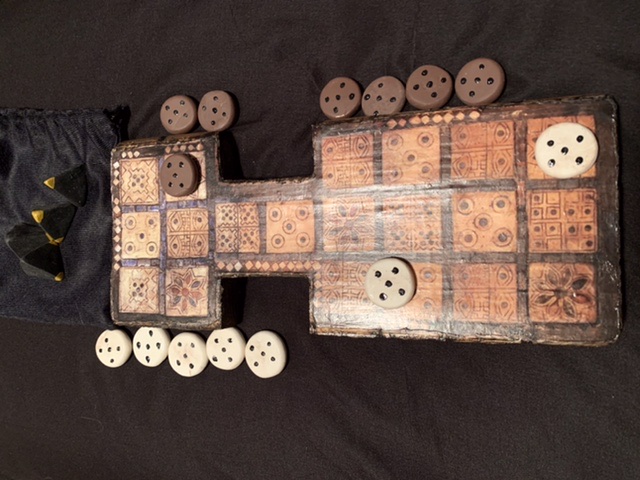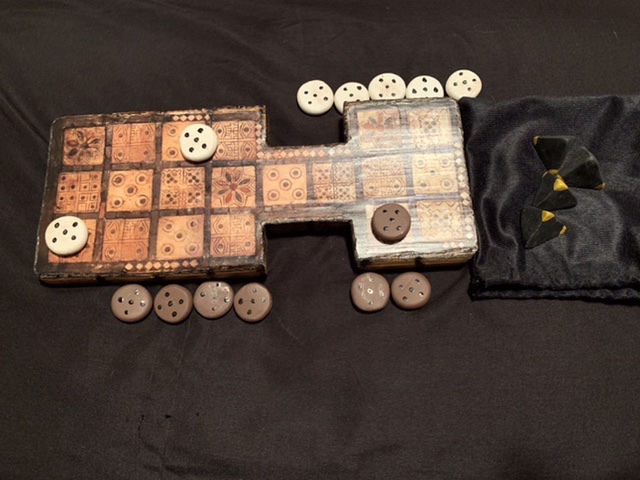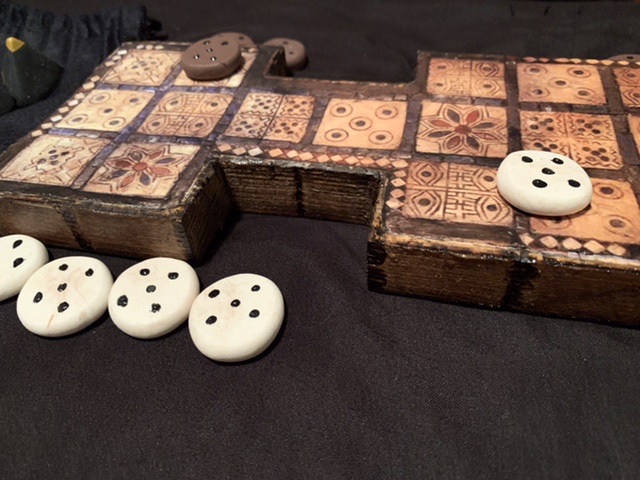Alternate Names
The ancient name of this game is unknown. It is also called the Game of Twenty Squares.
No. of Players
Probably two.
Equipment
The Royal Game of Ur board was accompanied by equipment comprising fourteen counters made of shell that are marked differently on either side, seven each of black and white, as well as six tetrahedral (pyramidal) dice, each of which has two of its four points dotted with inlay.
Printable Royal Game of Ur Board
History
The archaeological site of Ur lies in the south of present-day Iraq at the junction of the Tigris and Euphrates Rivers and was once capital of the Sumerian Empire and reputedly the home of the biblical Abraham. Amongst the many archaeological treasures yielded from the site of Ur come some of the oldest game board artifacts known. During excavation of the royal tombs in 1926-7, led by Sir Leonard Woolley in conjunction with the British Museum and the University of Pennsylvania, four boards were discovered. The ancient Sumerian name of this game is not known, but it is today typically referred to as the Royal Game of Ur. The oldest of these boards has been dated at around 2600 BCE. Some of the rules for this game have been found on a cuneiform tablet dated around 200 BCE. The boards differ greatly in terms of their designs, but all feature the rosettes in the same pattern and some do not contain any design other than the rosettes. This factor leads many game historians to believe that the rosettes are the only detail of the board with significance to the play of the game. This is not to say that games featuring other designs at other positions on the board do not implement them into play of the game. It is likely that there were many variations of this game incorporating different rules.
Objective
This game is almost certainly a race game and thus the objective is for all seven of a player’s counters to reach the end. Where exactly on the board the beginning and end of this race lie is a matter of some speculation.
Play
Various potential recreations of the method of play for this game have been proposed. Any of them should work, provided that both players agree on all the details prior to commencing the game.
RollThe distance moved is determined by a player’s roll of the dice. Using the historically correct dice shown above, it is assumed that each player rolls three dice on their turn to determine the distance traveled. If three dice are rolled there are four possibilities of equal probability: that 0, 1, 2, or 3 of the upturned points will be red. Here, 1, 2, and 3 upturned points will give a move of that value where zero upturned red tips will give a move of four. To substitute normal gambling dice, simply roll one die until achieving a roll of 1, 2, 3, or 4 (roll again if 5 or 6 shows). A roll of the dice should also likely define the entrance of the counters onto the board. Any roll number can be defined as the entrance number. I suggest a roll of one (one upturned point) allowing a player to enter a counter on the first square of the route (see below).
RouteGiven that the rosettes always appear in the same pattern on different boards it seems likely that they are significant and thus a route which spaces them evenly apart seems logical. Such a route was first described by the games historian H. J. R. Murray. Using this route, a counter passes or lands on a rosette every four spaces.
The proposed route of counters around the Tau board is the same as for the Jiroft Games.
Upon reaching the third rosette at the top of the board, a counter is flipped over to show its reverse side to designate that it is on its return route.
RosetteThe significance of the rosettes is also a matter of some speculation. On first thought, it might seem likely to be a “safe place” where a counter can stay and not be captured. This, however, seems unlikely as two of the rosettes occur in places where the counter’s routes do not cross. More likely, the rosettes entitle a player to another roll of the dice upon landing on them.
ReturnSimilar to the play of backgammon today, a counter may be taken from the board when landed upon by an enemy counter, and will then need to be reentered from the start. Counters of the same player, however, may be stacked on one another when a move so allows it. The counters may then be moved as a team for any roll or can be separated as desired by roll. However, the opponent may capture an entire stack by landing on it, sending all counters it contains to the start.
Variations Some variations, where the counters follow the same route as given here, allow special rolls to move a counter that is at a rosette ahead to the next rosette. |


